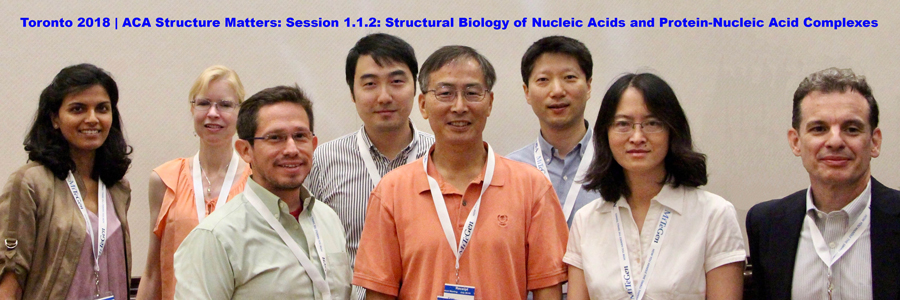News
Wedekind Co-Organizes Nucleic Acids Session at American Crystallographic Association Annual Meeting in Toronto
Friday, November 9, 2018

Highlights of Session 1.1.2 on Nucleic Acid were reported in ACA RefleXions Fall 2018 and provided many new insights into the form and function of nucleic acids and was co-organized by Dr. Joseph Wedekind and Dr. Rui Zhao. Dr. Wen Zhang of Harvard University presented mechanistic studies of non-enzymatic RNA polymerization using custom phosphoramidites with imidazole leaving groups that were caught in the act of catalysis by crystallographic snapshots. This work has implications for catalysis in a pre-biotic RNA world. Sun Cheol Park from Kangwon National University, Korea described DNA recognition by the PadR repressor. Binding of phenolic acid blocks DNA binding to relieve PadR repression, activating downstream detoxification genes. Dr. Yun-Xing Wang from NIH/NCI described use of an X-ray free electron laser to capture conformational changes of the adenine riboswitch during effector binding, providing insights into RNA-mediated translational regulation.
Prof. Clara Kielkopf from the University of Rochester described progress to decode the basis of 3´-splice site recognition of pre-mRNA by U2AF proteins, including polypyrimidine tract recognition and binding to degenerate splice-sites. The work has implications for correction of splicing defects found in human diseases. Dr. Eric Montemayor from the University of Wisconsin described later steps of pre-mRNA splicing, including a model for U6 snRNA remodeling by contacts to the Lsm2-8 ring protein and the Prp24 chaperone. Dr. Soumya Remesh from the Lawrence Berkeley National Lab used small angle scattering and soft X-ray tomography to reveal how small molecules interact with the abundant HU protein to alter DNA supercoiling. The work has implications for controlling bacterial gene expression. The session was anchored by Dr. Ailong Ke of Cornell University who presented structural snapshots that contribute a novel mechanistic framework to describe how bacterial type II-A CRISPR systems create new molecular memories of short, foreign 'spacer' DNAs that invade bacterial cells.
Wedekind Lab Co-Crystal Structure of HIV RNA in complex with a Lab-Evolved Protein on the Cover of Nucleic Acids Research
Tuesday, July 31, 2018

Co-crystal structure of HIV trans-activation response (TAR) RNA (rainbow ribbon) in complex with lab-evolved protein, TBP6.7 (blue Cα ribbon). A short peptide (pink) binds TAR outside the context of TBP6.7. (art by Joseph Wedekind). The underlying electron micrograph shows HIV virions (CDC image #13472 by Maureen Metcalfe and Tom Hodge).
Nucleic Acids Research Breakthrough article describes structure of HIV TAR complex with engineered binding protein and structure-based synthesis of antagonist
Investigators at multiple research institutes, led by Dr. Joseph Wedekind (University of Rochester) have described the high resolution crystal structure of a laboratory-evolved protein bound to its tightly associated HIV TAR RNA target, and subsequent synthesis and characterization of a stapled peptide mimic of the predominant RNA binding epitope in that protein. The study provided a detailed framework for peptide-mediated TAR recognition that might be generally applicable to target other disease-relevant RNAs.
HIV/AIDS is a global health threat that requires new insights into viral targets, especially those that resist mutation and promote novel aspects of the viral life cycle. In these respects, the HIV-1 trans-activation response (TAR) RNA is of ongoing interest. Previously, investigators (including some from this author group) developed methods to produce a unique lab-evolved protein ('TBP6.7') that recognizes TAR with extraordinarily high affinity compared to known TAR binders [Crawford et al. McNaughton (2016) ACS Chem. Biol. 8, 2206]. However, the molecular determinants of TAR recognition remained obscure, thus limiting the investigators' ability to further exploit that discovery. The crystal structure of this complex allowed investigators to determine that only a subset of the 'evolved' protein sequences are actually involved in RNA binding, with the preponderance of interactions localized to a short β-hairpin. This observation led them to synthesize a short, stapled peptide that mimics the β-hairpin and attenuates TAR-dependent transcription in HeLa nuclear lysate.
The study reported here [Belashov et al. Wedekind (2018) Nucleic Acids Res. 46, 6401-6415] is highly multi-disciplinary, spanning crystallography, site-directed mutagenesis, calorimetry, cell-surface display, ELISA, transcription assays, molecular dynamics simulations, and constrained peptide synthesis. In the end, the conversion of the parental RNA binding protein from single- to double-stranded RNA recognition implies that the protein has sufficient plasticity to recognize numerous RNA folds.
Reviewers and editors familiar with the work have stated that the study is "a strong contribution to a difficult field" that "will have substantial impact in the field of RNA recognition, ranging from applied (specifically targeting therapeutically relevant RNAs) to basic (understanding how RRMs bind to specific RNAs in the cell)"
The Wedekind laboratory at the University of Rochester investigates the mechanisms of action of non-protein-coding (nc)RNAs, and is interested especially in the three-dimensional architectures of these RNAs and how they bind to specific small molecules or peptides, leading to conformations that alter biological function. The research was supported by the University of Rochester Center for AIDS Research, and the National Institutes of Health.